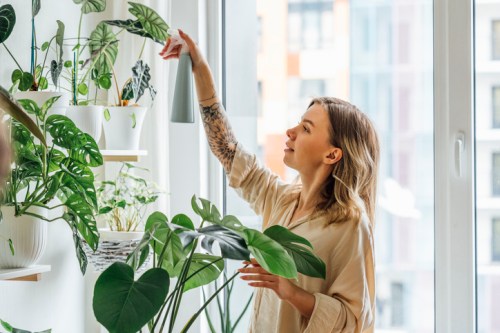When cleaning day arrives, you may not even think about dusting your plants. Like forgetting to scrub the knife block or treat the grimy shower curtains, overlooking your indoor jungle is a common cleaning mistake. But learning how to dust your plants the right way is a key to their longevity—just ask someone with a professional green thumb.
Experts in This Article
former director of brand marketing at The Sill
Ahead, Erin Marino, director of brand marketing at The Sill, explains why dusting your greenery is key to being a good plant mom, how often you should clean them up, and how to spruce without harming them. Grab your duster (or cloth) and take care of the plant fam.
Why should you clean your plants in the first place?
If you’re thinking: “What’s wrong with a little dust! I’m sure my fiddle leaf fig can handle it”—Marino begs to differ.
“Plants can clean the air around them in two ways: physically and chemically. Physically, they purify the air by having a static charge and acting as a dust cling. That’s why you’ll notice some plants get so dusty—it’s because they’re actively removing the physical dust particles from the air surrounding them,” she explains. So just to reiterate that, your plants are already doing some dusting for you. (How cute!) But you have to make sure you’re taking care of them in return.
Why? Over time, these dust particles tend to build up, clogging the pores or your plants, which are called stomata. “These tiny pores are crucial for many plant functions—they allow oxygen to pass through for the process of respiration; they allow carbon dioxide to pass through for the process of photosynthesis; and they allow water vapor to pass through for the process of transpiration,” says Marino.
When these pores are blocked, these key gas exchanges can’t happen as efficiently and your indoor plants can’t live their best lives. So, you see, your fiddle leaf fig does need you—no matter how independent she seems.
How often do your plants need dusting?
It depends on how dusty your space gets, but generally, Marino recommends giving your plant babies a dusting every one to two months. “It’s more of a best practice. You could go longer, but it’s good to at least check your plants’ foliage every few weeks for dust buildup, signs of plants pests, or anything else out of the ordinary,” she says. “You might find, like I do, that giving your plants a little extra TLC here and there can be meditative to do, and rewarding to see the benefits of.”
The best methods for dusting plants
1. Wipe the leaves with a damp cloth
Grab a clean cloth, wet it, and wring it out until it’s just damp. Gently wipe the cloth over all the leaves of each plant. “If you want to include a little bit of diluted hand soap on your cloth, that’s fine too, just remember to dilute with water and stay clear of any harsh cleaners. I try to think of it like, if I wouldn’t wash my skin with it, I shouldn’t use it to wash my plants’ leaves either. I skip any leaf shine products, always, which can clog stomata just like dust would,” adds Marino.
2. Pass a duster (gently!) over the leaves
Dusting the rest of your place? Go ahead and include your plants in the spruce—just make sure that the duster is clean by the time you get to your ivies, ferns, and bamboos.
3. Brush your leaves and make it meditative
“If you enjoy the meditative process, you can get more detailed with it: Wet your cloth, or sponge, and wring out any excess water. Support each leaf with one hand gently from under and wipe down, away from the stem very carefully with the other hand. Get to the undersides too,” says Marino. Make sure you use a small, delicate brush for tinier leaves.
4. Rinse your plants’ leaves on watering day
We get it, we get it: You don’t always have time to spend hours tending to your plants. Luckily, Marino has a quick cleaning fix for those days. “Sometimes, if I’m short on time—or don’t want to waste paper towels—and know the plant will dry out quickly due to a sunny day, I’ll rinse their leaves under the sink while I water them. A quick rinse always does the trick of washing away any dust buildup,” she says. Once you’re through, gently shake your plants to rid their leaves of excess water that could cause fungal infections or brown spots.
Oh hi! You look like someone who loves free workouts, discounts for cutting-edge wellness brands, and exclusive Well+Good content. Sign up for Well+, our online community of wellness insiders, and unlock your rewards instantly.
Sign Up for Our Daily Newsletter
Get all the latest in wellness, trends, food, fitness, beauty, and more delivered right to your inbox.
Got it, you've been added to our email list.











